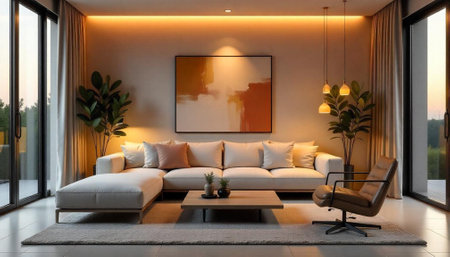Defining Layered Lighting within British Interiors
Layered lighting, at its core, is the strategic use of multiple light sources to create a harmonious and functional environment. In the context of British interiors—ranging from the time-honoured Georgian townhouse to the sleek, modern flat—the concept takes on a unique character. Unlike continental Europe, where sunlight often pours through grand windows, British homes are shaped by softer, more capricious daylight due to the UK’s famously changeable weather and shorter winter days. This makes thoughtful artificial lighting not merely decorative, but essential. Layered lighting in Britain involves balancing ambient, task, and accent illumination to respond to both architectural idiosyncrasies and the subtleties of natural light. For instance, the deep coving and high ceilings of Victorian terraces invite statement chandeliers paired with discreet wall sconces, while contemporary open-plan spaces benefit from recessed LEDs and sculptural pendants that echo minimalist sensibilities. Understanding these nuances is crucial; each layer serves not only a practical role but also enhances period features or highlights modern finishes, ensuring British interiors remain inviting throughout the year’s shifting light.
2. Ambient Lighting: Setting the Backbone
Ambient lighting is the quiet hero of British interiors, forming the essential layer that shapes how a space feels from the moment you step in. In homes ranging from charming Victorian terraces to sleek city flats, the approach to ambient illumination must be both practical and mindful of Britain’s unique interplay with natural daylight. To achieve this foundational glow, it’s important to strike a balance between historical character and contemporary comfort.
The Role of Ambient Lighting in British Homes
Ambient lighting serves as the backbone upon which all other lighting layers are built. It provides a uniform base level of light, ensuring rooms are welcoming throughout the day and evening—especially crucial during long, grey winters when natural light is scarce. The key lies in selecting fixtures that not only provide sufficient brightness but also complement the architectural style of the property.
Statement Pendants vs. Subtle Ceiling Fixtures
| Setting | Lighting Approach | Cultural Context |
|---|---|---|
| Victorian Terraces | Ornate statement pendants or chandeliers as focal points, often with dimmer controls for adaptability | Reflects period elegance and enhances high ceilings and original mouldings |
| Edwardian & Georgian Townhouses | Layered ceiling lights with classic shades or glass diffusers for softer diffusion | Balances historic detail with warm, inviting ambience for entertaining and everyday living |
| Modern Flats & New Builds | Sleek flush-mounted fixtures or recessed LEDs for minimalist effect; smart systems for mood control | Aligns with contemporary tastes and maximises limited ceiling heights while offering flexibility across seasons |
Responding to Britain’s Changing Daylight
The British climate is famously unpredictable, and daylight hours vary dramatically with the seasons. As such, ambient lighting strategies must adapt:
- Winter: Increase lumens and favour warmer colour temperatures (around 2700K-3000K) to counteract gloomy afternoons.
- Summer: Use dimmable fittings to complement abundant evening light and prevent harsh contrasts at dusk.
- Transitional Periods: Layer ambient sources—such as combining central pendants with wall washers—to ensure continuity as natural light shifts.
A thoughtful approach to ambient lighting not only respects the heritage of British interiors but also supports daily life through every season, laying a flexible groundwork for more decorative and task-oriented lighting elements yet to come.
![]()
3. Task Lighting: Enhancing Daily Life
Task lighting stands at the heart of functional British interiors, providing focused illumination for everyday activities across various living spaces. Unlike ambient lighting, which creates atmosphere, task lighting is precision-driven—designed to brighten specific areas where clarity and concentration are paramount. Let’s delve into how task lighting shapes daily routines in British homes, from classic reading nooks to bustling kitchen worktops and productive home offices.
Reading Nooks: Creating Cosy Corners
Britain’s love affair with literature is well-served by thoughtfully lit reading nooks. Adjustable wall-mounted lamps or directional floor lights positioned beside a favourite armchair not only reduce eye strain during long reading sessions but also add a touch of intimacy to the space. Opting for LED bulbs ensures energy efficiency—a must in eco-conscious UK households—while dimmable features cater to personal preference and the ever-changing British daylight.
Kitchen Worktops: Precision Where It Matters
The kitchen, often the social hub of British homes, demands practical lighting solutions that support both culinary creativity and safety. Under-cabinet LED strips or spotlights provide shadow-free illumination directly onto work surfaces, essential for everything from chopping vegetables to perfecting the Sunday roast. Energy-saving LEDs are favoured not only for their longevity but also for their low running costs—key considerations given rising UK energy prices. Many homeowners now integrate smart controls to adjust brightness according to the time of day or specific tasks at hand.
Home Offices: Supporting Productivity
With remote work firmly established in British lifestyles, dedicated home office zones require tailored task lighting to prevent fatigue and maintain focus. Desk lamps with adjustable arms and colour temperature settings offer flexible solutions, adapting from crisp white light for video calls to warmer tones for late-night emails. Energy-efficient options abound, with many Brits choosing lamps featuring automatic shut-off timers or motion sensors to further minimise electricity use.
Practical Solutions for Modern UK Living
The British approach to task lighting blends practicality with environmental consciousness. Selecting fixtures that support LED technology, integrating smart controls, and prioritising adjustable designs ensures each space meets both lifestyle needs and sustainability goals. Whether highlighting a cherished book collection or illuminating a sleek kitchen island, well-planned task lighting elevates comfort and efficiency throughout the home—making it an indispensable layer in transforming British interiors.
4. Accent Lighting: Highlighting Heritage and Character
In the context of British interiors, where period features and a sense of storied heritage are often at the heart of design, accent lighting becomes an indispensable tool for elevating both tradition and individuality. Distinct from ambient or task lighting, accent lighting is all about drawing the eye to what makes a space unique—be it an ornate cornice in a Georgian townhouse, a treasured portrait above a Victorian fireplace, or a meticulously curated collection of ceramics displayed in an Edwardian alcove.
The Role of Accent Lighting in British Homes
Accent lighting serves to celebrate the rich architectural details that characterise many UK homes. By selectively illuminating cornices, mouldings, exposed brickwork, or stained glass panels, homeowners can honour the craftsmanship of bygone eras while still keeping their interiors feeling fresh and relevant. This approach not only preserves the narrative thread of British history but also allows for personal touches to shine through—think spotlights on contemporary art pieces or vintage memorabilia that reflect the homeowners own story.
Choosing the Right Fixtures
When it comes to implementing accent lighting within British interiors, a thoughtful selection of fixtures is key. Below is a quick guide on how different types of accent lights can enhance specific features:
| Accent Light Type | Ideal Use Case | British Context Example |
|---|---|---|
| Spotlights | Focused beams highlight single objects or features | Illuminating crown mouldings or historical portraits in period lounges |
| Wall Washers | Broad, even light enhances textured walls or large artworks | Showcasing exposed brickwork in converted warehouses or gallery walls in modern flats |
| Table Lamps | Adds intimacy and warmth; highlights smaller vignettes | Casting a gentle glow over collections of books or ceramics on sideboards in classic studies |
Practical Guidance for Layering Accent Light
- Balance with Ambient Sources: Accent lighting should complement rather than overpower existing ambient light. In traditional British settings with lower ceilings or darker wall colours, choose dimmable options to maintain mood.
- Honour Architectural Lines: Position spotlights to graze along coving or picture rails, emphasising the geometry and craftsmanship typical of British architecture.
- Create Focal Points: Use table lamps on antique writing desks or console tables to draw attention to curated arrangements of family heirlooms or local artisan crafts.
Cultural Considerations
The subtlety inherent in British style favours layered, understated elegance over bold statements. Opt for fixtures in finishes like aged brass, burnished copper, or classic porcelain that nod respectfully to local traditions. Ultimately, well-considered accent lighting not only celebrates heritage but enables each home to tell its own distinctly British story.
5. Selecting Fixtures: From Classic to Contemporary
When it comes to layered lighting in British interiors, selecting the right fixtures is both an art and a nod to the nation’s rich architectural heritage. Every home, whether a stately Georgian terrace or a sleek urban flat, benefits from lighting choices that echo its character while embracing contemporary needs.
Honouring Heritage: Lighting for Period Homes
Georgian Elegance: For homes with Georgian features—think high ceilings, ornate cornices, and sash windows—opt for fixtures that celebrate symmetry and refinement. Classic chandeliers or glass lanterns in aged brass or antique finishes complement these spaces without overpowering their historical charm. Wall sconces with soft, diffused shades are ideal for creating ambient layers while respecting the room’s original proportions.
Art Deco Drama: British Art Deco properties demand a touch of glamour. Consider geometric pendant lights, stepped uplighters, or frosted glass shades with chrome detailing. Such fixtures not only reference the 1920s-30s era but also provide bold focal points in living rooms or hallways, seamlessly blending heritage with modern sensibility.
Contemporary Contrasts: Urban Minimalism
For those living in converted warehouses or new-build flats, minimalist lighting works wonders. Clean-lined track lights or recessed LED spots deliver functional illumination without cluttering visual space. Statement floor lamps in matte black or brushed steel can inject personality into open-plan layouts while maintaining a crisp, understated aesthetic typical of modern British city living.
Balancing Tradition and Trend
The key to transforming UK interiors lies in embracing interplay—mixing vintage finds with contemporary pieces. A Victorian ceiling rose might cradle a bold industrial pendant; classic candelabra wall lights could frame abstract art. This balance allows homeowners to honour Britain’s past while reflecting evolving tastes and lifestyles.
Layered Lighting as Cultural Expression
Ultimately, fixture selection in British homes is more than just practical; it’s deeply cultural. Whether drawing inspiration from historical periods or today’s design trends, layered lighting empowers individuals to express identity and celebrate the diverse tapestry of British architecture—one well-chosen light at a time.
6. Sustainability and Smart Lighting in the British Home
As British interiors continue to evolve, there is an unmistakable shift towards sustainability and technological integration in lighting design. Homeowners are increasingly considering eco-friendly options that not only reduce environmental impact but also align with a refined sense of style. The adoption of LED technology stands at the forefront of this movement, offering remarkable energy efficiency, longevity, and flexibility in layered lighting schemes. LEDs make it possible to achieve a warm, inviting ambience reminiscent of traditional British homes while drastically reducing electricity consumption.
The Rise of Smart Lighting Systems
British households are embracing smart lighting systems that allow for unparalleled control over mood, timing, and energy usage. These systems can be tailored to daily routines—dimming gently in the evenings or providing a crisp brightness on gloomy winter mornings—all managed via smartphone apps or voice assistants. Such innovations reflect a quintessentially British appreciation for both tradition and innovation, blending heritage aesthetics with contemporary convenience.
Balancing Ethics and Aesthetics
Choosing sustainable lighting doesn’t mean compromising on character or charm. Modern eco-friendly fixtures come in a variety of styles, from vintage-inspired pendants perfect for Victorian terraces to sleek minimalist fittings for modern flats. By selecting materials such as recycled glass or responsibly sourced metals, homeowners can further reinforce their ethical choices without sacrificing visual appeal.
A Future-Proof Approach
The integration of sustainable practices and smart technology positions British interiors at the cutting edge of design while honouring their storied past. As awareness grows around climate impact and resource conservation, layered lighting strategies will increasingly revolve around both beauty and responsibility—ensuring that British homes remain stylish, adaptable, and environmentally conscious for generations to come.


